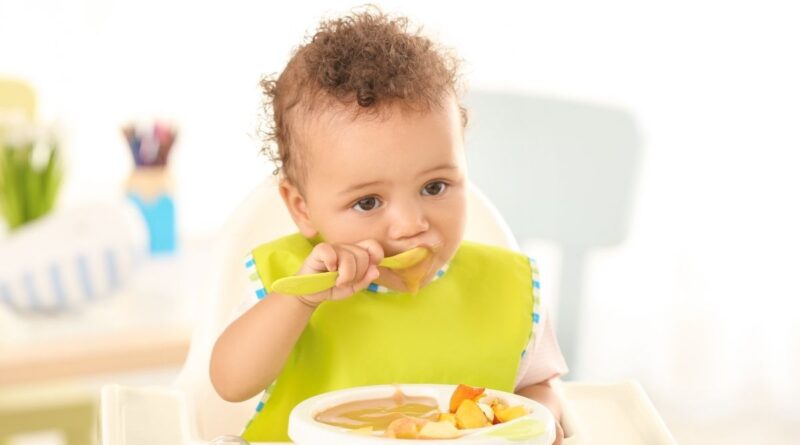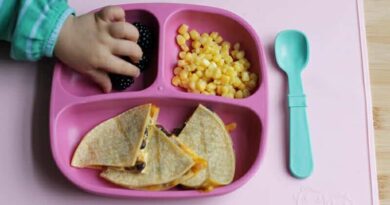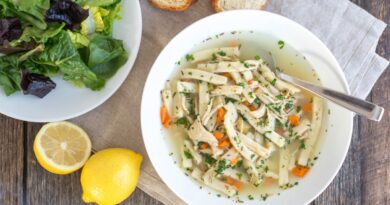Baby Led Weaning vs Purees – What is the Best Approach to Feeding Your Baby?
The start of weaning is such a milestone. Deciding whether to choose baby led weaning vs purees is one of the most common questions that I get asked.
When your baby is around 6 months old, breast milk or formula does not provide enough nutrition that babies now need to grow, play and thrive which is why the food that you offer them is so important!
But weaning on to solids is about so much more than just nutrition.
It helps to develop their motor skills, teaches them social and communication skills and develops their brains through a sensory experience.
It’s an exciting time when babies learn lots of new skills and behaviours.
Let me talk you through each option so that you can really understand what they involve.
This blog contains affiliate links.

What is Baby-Led Weaning (BLW)?
Baby led weaning or BLW involves giving your baby chunks of food right from the start of weaning. It gives your baby greater responsibility in deciding what to eat and how much to eat as they are feeding themselves!
This type of weaning has been very popular since the early 2000’s and is generally credited to Gill Rapley.
Instead of making up batches of pureed baby food, you cook family foods and serve these to your baby, letting your baby lead the way and feed themselves.

What is Traditional Puree Weaning?
This involves parents spoon feeding their baby food that has been made into a developmentally appropriate form.
At the start of weaning babies can only move liquids and very thin foods from the front to the back of their mouths and swallow.
Over time as they begin to develop their eating skills, they can manage thicker and more complex textures.
Babies who are being weaned onto solids in the traditional way still eat finger foods from around 6 ½ months of age.

How to Choose between Baby Led Weaning vs Purees
When you are getting ready for weaning, this is bound to be a question you’ll ask yourself and discuss with your friends who have babies the same age.
In the following section I’m going to take you through the considerations for each approach so by the end you will be able to make an informed decision on baby led weaning vs purees and what’s best for you and your baby.

What age should they be?
When thinking about baby-led weaning you need to be aware that babies need to be developmentally ready to manage non-puree foods, so it’s important that you don’t start before 6 months of age.
Even if your little one is showing all of the signs of readiness for weaning they won’t yet be proficient at moving food around their mouth to be able to safely swallow it which means they are at a greater risk of choking.
If you want to start solids before 6 months it’s best to start with purees.

What first food should you offer when BLW?
Baby led weaning babies just don’t consume the same volume of food that traditional spoon fed babies do.
This means they get less nutrition in the first few months of weaning.
Because of this, I advise a different range of foods as first foods for baby led weaning.
Rather than an abundance of fruit and veg, first foods should be highly nutritious and include:
- eggs
- whole yoghurt
- dark chicken meat
- oily fish like salmon
- slow cooked beef and/or lamb
- minced beef shaped into burgers or sausages
- buttered toast
- olive & rapeseed oil
- cheese
- avocado
- smooth nut butters
- fingers of steamed sweet potato

What about the veg first approach?
Research has found that babies who are introduced to vegetables first are more likely to be eating vegetables when they grow into older children.
The key appears to be giving different single vegetables at each meal but repeating those vegetables frequently so that your baby gets used to them.
Sweeter vegetables like butternut squash or carrot will be more readily accepted as your baby’s sweet taste buds are more mature, and bitter vegetables like spinach or courgette may take a little more getting used to.
Therefore it makes sense to get them used to bitterness first before moving on to the sweeter tastes.
If you are baby led weaning, offer these alongside the more nutritious foods listed above.
If you are traditional spoon weaning you can give vegetable purees for the first 7-10 days before moving on to more nutritious foods.

Textures of food
Baby-led weaning babies are at no greater risk of choking than a baby who is puree weaning.
Despite this it’s still important to only offer foods that your little one is developmentally ready to eat to minimise the risk.
To minimise these concerns, I suggest:
- Avoiding whole nuts. Use nut butters, thinned with milk if needed and ground nuts instead.
- Cut foods up that may be a choking hazard such as cherry tomatoes, giant blueberries, whole cherries and whole grapes.
- Avoid hard foods that your baby can break pieces off with their gums but can’t yet chew and swallow, such as raw carrot or apple.
- Avoid hard crackers that crumble such as rice crackers, crisps or tortilla chips. Instead start with meltable versions such as melty puffs.
- Avoid popcorn, hot dogs and raw jelly cubes – these foods are just not needed by babies anyway!

Advantages of Baby-Led Weaning
Baby-led weaning has several advantages.
It can help to develop your baby’s fine motor skills, promote a positive relationship with food, and make mealtimes more enjoyable for the whole family.
Developing Motor Skills
Picking up food and bringing it to their mouth requires coordination and control, which can help to strengthen your baby’s hand-eye coordination and fine motor skills.

Promoting Healthy Eating Habits
Baby-led weaning can also help to promote healthy eating habits.
By allowing your baby to choose what they eat and how much they eat, you can help them to foster a positive relationship with food by allowing hem to eat in response to their own hunger and fullness cues.
Enhancing Sensory Exploration
Baby-led weaning encourages sensory exploration.
Offer a variety of foods that your baby can explore with their senses. Offer different colours, shapes, tastes, textures, temperatures and smells.
Exploring food through play helps babies to learn about foods in a relaxed way and can lead to better acceptance of new foods.

Advantages of Purees
Purees also have several benefits for your baby.
Nutrient Control and Variety
One of the main benefits of puree weaning is that parents know precisely what their baby has actually eaten.
You can have more control ensuring your baby is getting a balanced diet by combining different fruits, vegetables, and sources of protein in their purees.
As purees are usually spoon fed, babies tend to eat more volume in the early days when compared to their BLW friends.

Easing Digestion
Purees can also be easier for babies to digest compared to baby led weaning foods.
The blender works in a similar way to how an adult would chew their food. It breaks down the food before it gets to your baby’s mouth!
This can be particularly beneficial for younger babies who are just starting on solids.
Easier for allergen Introduction
If your baby is at high risk of allergies, traditional puree weaning can be more helpful to ensure they eat the right amount of an allergen in order to test their tolerance.
Additionally, purees are a safer way to introduce potential allergens to your baby as when you introduce allergenic foods, you do them one at a time and in controlled amounts in order to monitor for any allergic reactions.
That’s not to say this is impossible with baby-led weaning, you just need to be more vigilant to ensure they get the correct dose.
If you are not sure how to introduce allergens to your baby you can check out our mini course.

Disadvantages of baby led weaning
Your baby may initially play with their food more than they eat it, which is great for their sensory development but does mean that in the early weeks of weaning your baby will get less nutrition compared to if they are weaning on purees.
You can make sure that you offer highly nutritious foods to help your baby get the nutrition that they need.
The mess! It can be terrible! You may be pulling your hair out at the end of every meal but there are some amazing trays that help you to catch the mess and some washcloths that make the clean up a bit more friendly.
Soon enough you’ll get into a routine with the clean up and it won’t seem so bad.
Whilst we know that baby led weaning doesn’t increase the risk of your little one choking, they are more likely to gag on new textures. This is because they are still learning how to control and move that new food around their mouth.
Gagging can be scary but this is a safety mechanism to prevent them from choking.
One of the downsides to baby led weaning is that you can’t start until your baby is 6 months of age as BLW foods puts them at a higher risk of choking. If you have been told that you need to start weaning sooner, it’s the traditional purees route that you need to go down.
If you have concerns, it’s always a good idea to speak to a registered paediatric dietitian to get advice on how to move forward.

Disadvantages of traditional spoon weaning
Choosing the puree style of weaning can mean countless hours in the kitchen, steaming, pureeing and freezing lots of little portions of food instead of simply serving up the family meal.
When you’re not eating the same meal together, you might also be tempted not to sit together to eat.
But babies learn so much from the social role modelling that happens around the family table and it also helps them to increase their confidence around foods by giving them a big smile to let them know that they are doing the right thing.
Many parents find that their baby eats smooth purees well and when they try to introduce lumps their baby will start to gag or to push the lumps out of their mouth.
This can cause parents to stay on those smooth purees for longer and miss key developmental windows for progressing with new textures.
Other considerations for baby led weaning vs purees
Whichever type of weaning you opt for there are a handful of other considerations you should know:

Signs of Readiness
Whether it’s baby led weaning vs purees, there are 3 main signs of developmental readiness for both types of weaning to look out for:
- Sitting up holding and their head steady
- Good hand-eye coordination so they can bring food up to their mouth
- Absence of the tongue thrust reflex so they can swallow food rather than push it back out.
You shouldn’t start weaning until your baby is showing all three of these signs and the majority of babies will be demonstrating these by the time they are 6 months (hence where the age came from).
However, a 4th sign of being ready for weaning is age.
If babies get to 6 months and not all 3 developmental signs have been met, you should start weaning anyway but following the purees approach.
This is because breastmilk and formula alone are no longer nutritionally adequate.
Interestingly many babies have the tongue thrust reflex well beyond 6 months and it takes practice with the spoon for that to go away.
If you would like to learn about 3 simple checks you can do with your baby at home to assess if they are developmentally ready, click here for my free online course which will talk you through exactly what you need to do.
Positioning and safety
As always, safety is the number one concern with babies and feeding is no different.
Your baby’s highchair plays a key role in their safety at mealtimes.

Choosing a highchair is more than finding something stylish and durable. It’s a crucial factor in your baby’s safely while learning to eat.
To practise the skills required for eating, your baby needs to give 100% attention to the job in hand.
Your baby’s priority is to protect their brain. It’s instinctive and cleverly they do this by focussing their concentration on stability, keeping themselves upright and not falling over.
This means that if they are prioritising stability, they can’t dedicate their full attention to learning the skills required for eating and drinking…
…and eating and drinking skills are one of the most complex tasks that human beings ever need to master.
A highchair with the right level of support can take away their need to concentrate on protecting their head, freeing up their focus to concentrate on the skills required for eating and drinking. This is irrespective of baby led weaning vs purees.
Here’s what you need to consider in a highchair:
The correct position – 90 degree angles at their waist, knees a feet.
A footrest where their feet can rest flat. So many highchairs don’t have these or they’re too low down and babies can’t reach them.
A backrest that goes right up to the back of the neck.
The tray position (or table top), it should be at nipple height.
When babies don’t have this level of stability, they are at greater risk of choking irrespective of whether you are baby led weaning or following the traditional approach. Most babies are ready to sit in a highchair at around 5-6 months of age.

Foods to avoid whether you are baby led weaning vs purees
Not all foods are safe for babies and there are certain foods that you should avoid giving to your baby till they are over 1 year of age.
- Honey
- Mould-ripened soft cheeses and cheeses made with unpasteurised milk
- Foods with added salt and sugar
- Whole cow’s milk as a main drink (although it can be used to prepare other foods)
- Shark, swordfish or marlin
- High choking-risk foods such as whole grapes or nuts
- Stimulants such as chocolate, tea and coffee
- Highly processed foods such as foods aimed at older children and tins, packets and jar foods aimed at adults.
This list applies to both types of weaning.

Deciding What’s Best for Your Baby
When it comes to deciding between baby led weaning vs purees, there’s no right or wrong answer.
The best approach depends on your baby’s age, developmental stage, your feeding preferences, as well as your own lifestyle, schedule, and feeding philosophy.
Every baby is unique, and what works for one baby may not work for another.
If your baby was born prematurely, they may not have the skills needed for baby-led weaning and may need to start with purees.
It’s important to discuss this with your baby’s healthcare team.
Oftentimes you can make a plan and then your baby will decide that they prefer the other method anyway!
That’s what happened to me with my spoon-refusing first baby and that was before baby-led weaning was even a thing!

Combining Baby-Led Weaning and Purees
It is totally ok to decide to do a combination of both approaches.
Baby led weaning babies still need to learn how to eat purees and spoon fed babies still need to learn how to eat finger foods.
In my view this allows the best of both worlds, the nutrition reassurance from the purees with the skill of baby led weaning.
It’s very easy to do, you might offer a puree as the main meal and then provide a few pieces of soft, cut-up fruit or vegetables as finger foods.
- At breakfast you could offer a smooth porridge with some soft cooked pear slices on the side.
- At lunch you could offer hummus on toast with yoghurt and fruit puree
- At dinner you could serve the family meal of spaghetti bolognese with penne pasta which is easier to hold and blending the bolognese sauce into a puree.

The post Baby Led Weaning vs Purees – What is the Best Approach to Feeding Your Baby? appeared first on The Children's Nutritionist.



